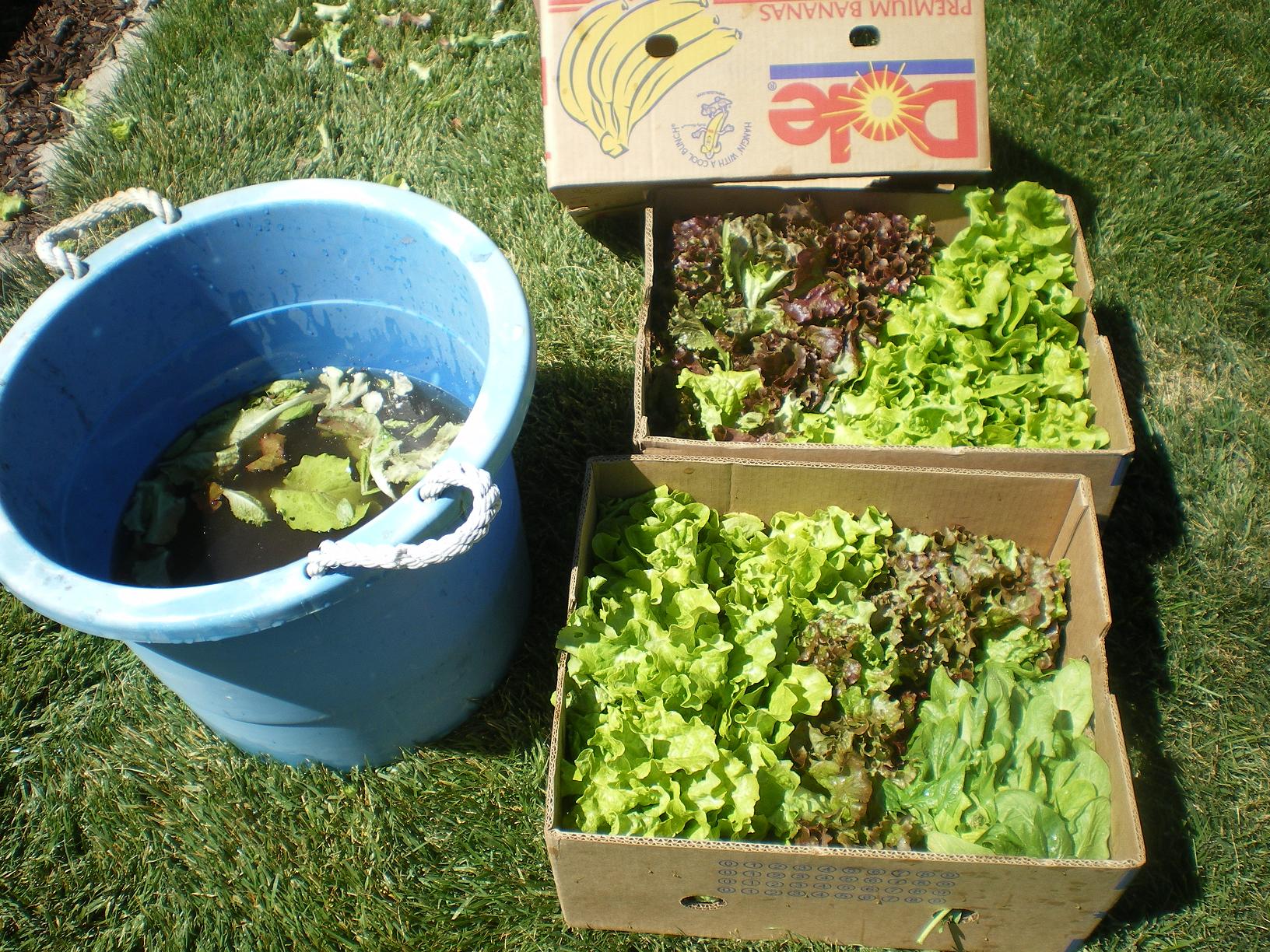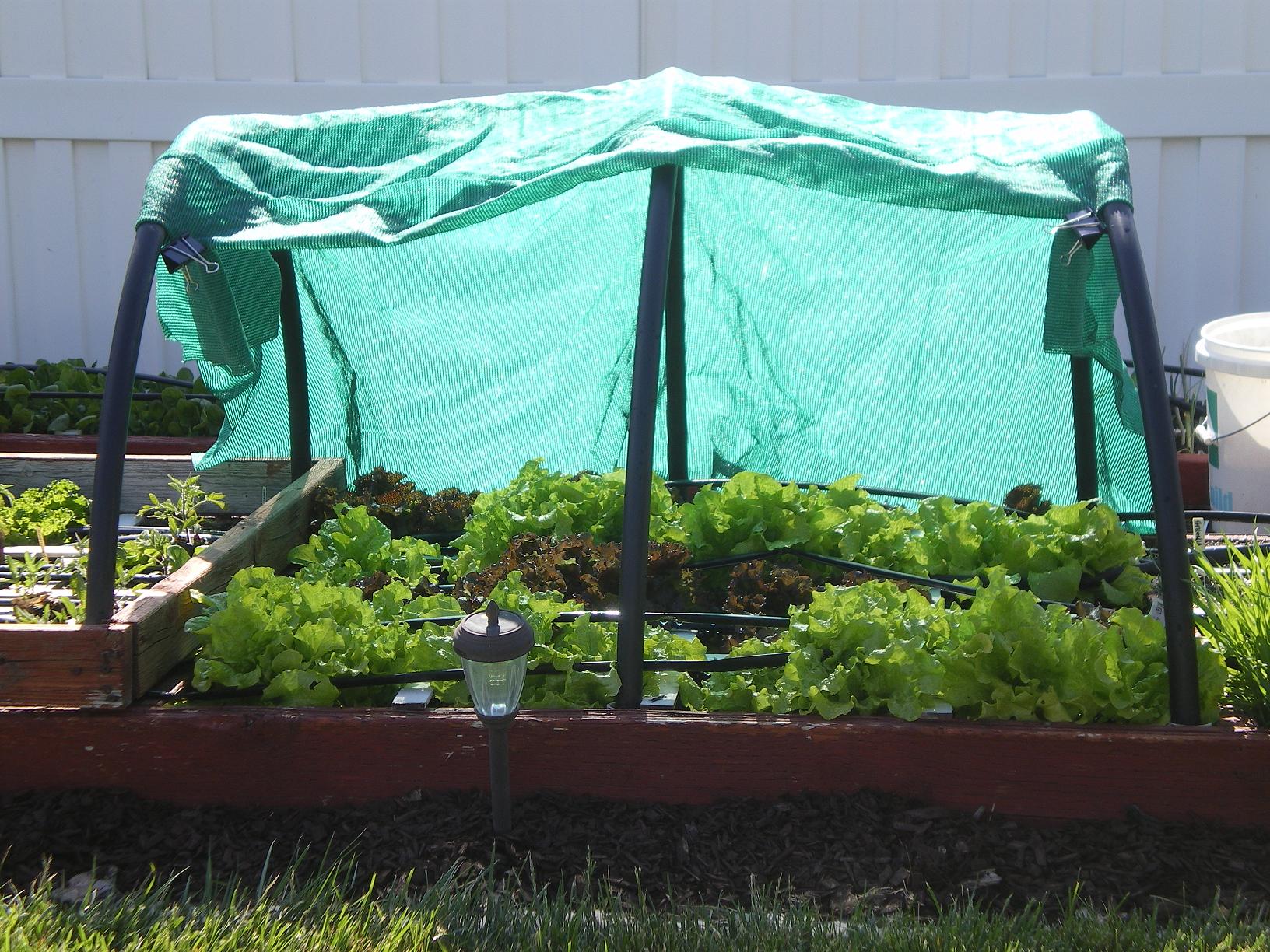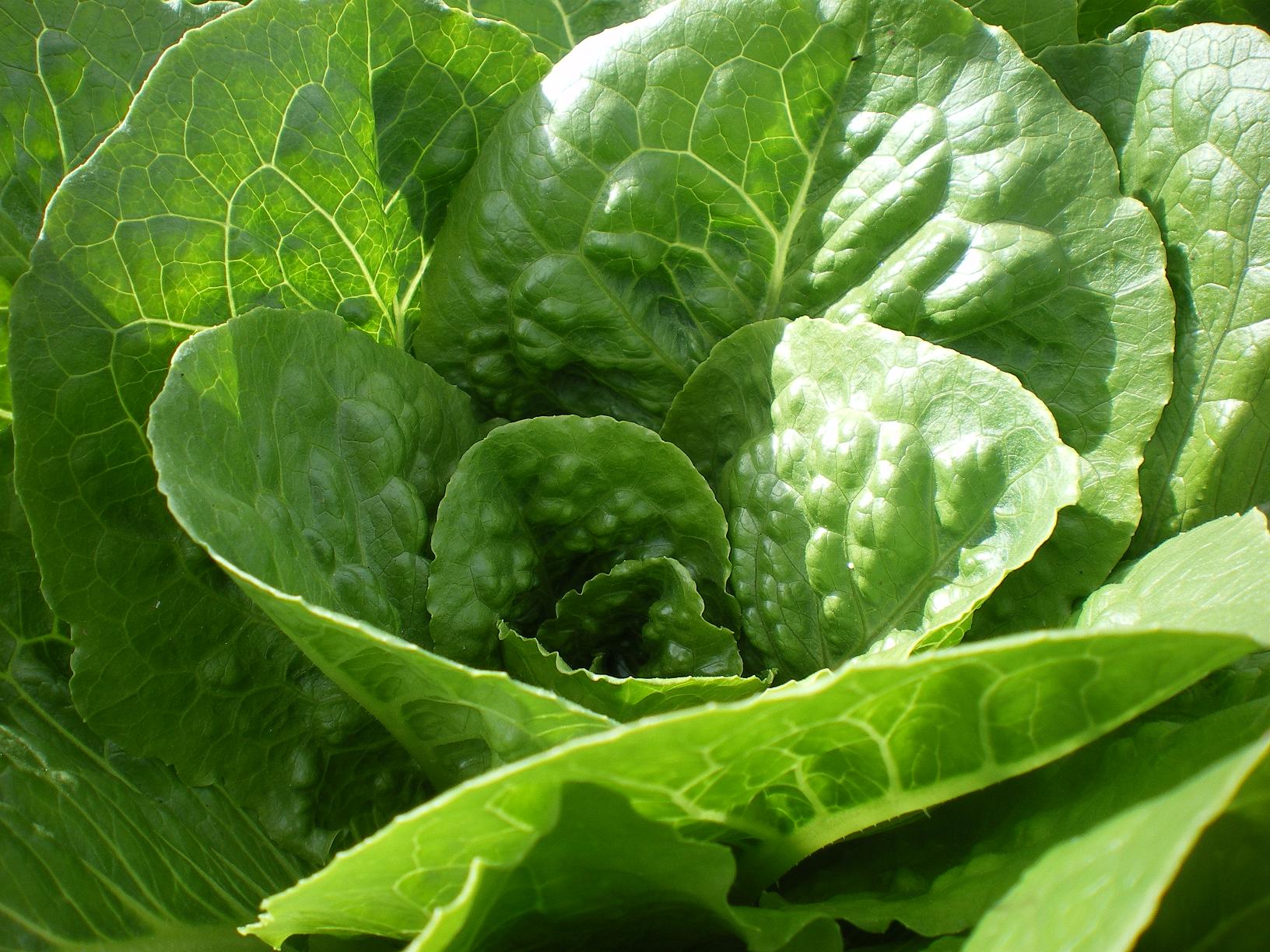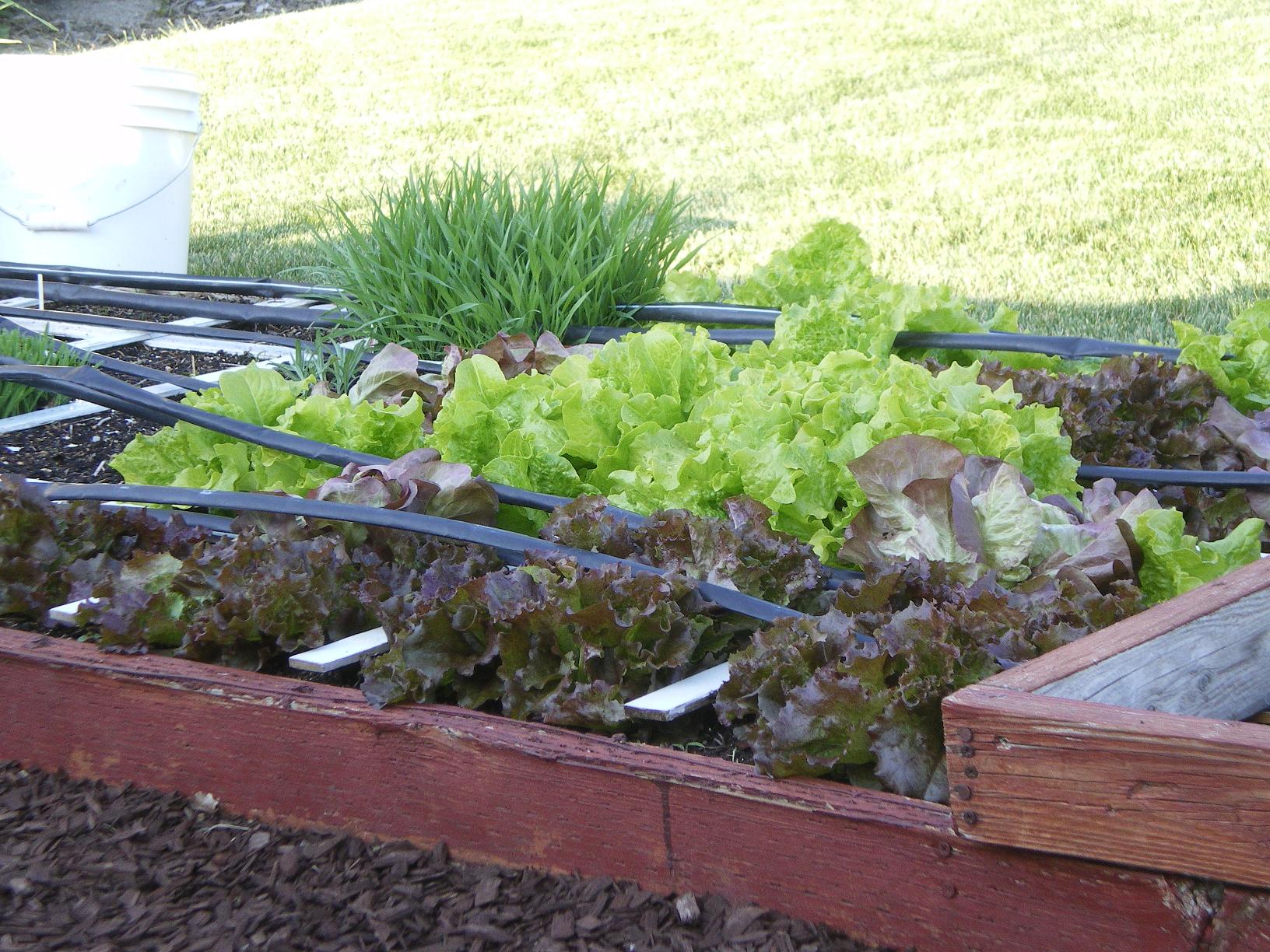 One of the main missions of the Square Foot Gardening Foundation is to eliminate world hunger. I don’t believe we will ever get there for a variety of reasons. While driving to work last week I heard of a nearby city putting flags in the ground for “homelessness awareness.” I wasn’t sure what that would do to help the homeless. It’s become a sensitive subject for me for personal reasons. This picture shows 2 of the 4 banana cartons that I was able to fill up with 64 heads of lettuce and 1-1/2 pounds of spinach. I don’t mention this for any accolades at all-none. It’s nothing to brag about and that’s not why I did it. It was a desire of mine to show what a simple little plot of land-in this case a 4X4′ square foot garden box-could produce without much effort. And it was done very cheaply. The seeds were maybe 4 or 5 years old and I used very little-2 or 3 seeds per hole. I think the packet were somewhere around $2 each. The only real cost was watering, and since I started this in early spring, I was able to let Mother Nature do the majority of the early watering. After that I hand watered, and if you’ve been following this blog, you’ll know how much less water a square foot garden takes than a single row garden. When it was time to harvest, I simply filled my trusty blue Rubbermaid tub(I have these all over the garden for little things like this), snipped the lettuce, gave it a quick rinse, drained them, then placed them in the boxes. I don’t know how many families it was able to feed but I’m sure it was a fair amount. My whole point was to show how easy it would be to truly make an impact on feeding the homeless. This was so easy to do and it cost very little. Fresh, totally organic, and delicious salad greens! How can you help? Would you consider taking a small area of your garden and dedicating that portion to grow food to make a donation to the local Food Bank? This was just one box! What if you had 3 or 4 boxes? Or what if you had a single 4X8′ box? That would give you 128 heads of lettuce in just 32 square feet! They sure were appreciative too-which is not the reason to do it. While others are sticking flags in the ground(which would have cost a whole lot more money than this did)you could actually be growing food to feed the hungry. Give it some thought. It really was simple.[ois skin=”below post”]
One of the main missions of the Square Foot Gardening Foundation is to eliminate world hunger. I don’t believe we will ever get there for a variety of reasons. While driving to work last week I heard of a nearby city putting flags in the ground for “homelessness awareness.” I wasn’t sure what that would do to help the homeless. It’s become a sensitive subject for me for personal reasons. This picture shows 2 of the 4 banana cartons that I was able to fill up with 64 heads of lettuce and 1-1/2 pounds of spinach. I don’t mention this for any accolades at all-none. It’s nothing to brag about and that’s not why I did it. It was a desire of mine to show what a simple little plot of land-in this case a 4X4′ square foot garden box-could produce without much effort. And it was done very cheaply. The seeds were maybe 4 or 5 years old and I used very little-2 or 3 seeds per hole. I think the packet were somewhere around $2 each. The only real cost was watering, and since I started this in early spring, I was able to let Mother Nature do the majority of the early watering. After that I hand watered, and if you’ve been following this blog, you’ll know how much less water a square foot garden takes than a single row garden. When it was time to harvest, I simply filled my trusty blue Rubbermaid tub(I have these all over the garden for little things like this), snipped the lettuce, gave it a quick rinse, drained them, then placed them in the boxes. I don’t know how many families it was able to feed but I’m sure it was a fair amount. My whole point was to show how easy it would be to truly make an impact on feeding the homeless. This was so easy to do and it cost very little. Fresh, totally organic, and delicious salad greens! How can you help? Would you consider taking a small area of your garden and dedicating that portion to grow food to make a donation to the local Food Bank? This was just one box! What if you had 3 or 4 boxes? Or what if you had a single 4X8′ box? That would give you 128 heads of lettuce in just 32 square feet! They sure were appreciative too-which is not the reason to do it. While others are sticking flags in the ground(which would have cost a whole lot more money than this did)you could actually be growing food to feed the hungry. Give it some thought. It really was simple.[ois skin=”below post”]
Tag Archives: lettuce
How to cool things down to grow lettuce and other cool weather items
 Since it’s starting to get hot outside and we want to be sure that we have lots of lettuce around when the tomatoes are ready, how do we cool our gardens down to ensure a continuous lettuce harvest? For starters, I always think it’s a good idea to keep the sun off your lettuce. Even if it’s under 80 degrees. But you’ll definitely want to keep the sun off your lettuce if it’s over 80. Somewhere between 80-85 degrees is where lettuce has a very hard time germinating. You have a couple of options. The first is to start your lettuce seeds inside-where it’s cool, and then transplant them outside when they’re ready. This is a great way to do it and to ensure a continuous harvest all summer. But it does require a little more work on your part. The other way is to direct seed right into the garden soil. When you’re hot what do you need? A little more water, and you sure could go for some extra shade. It’s the same thing with lettuce. If you cover it and give it a little more water, you’ll be able to grow lettuce all summer long-right through the hottest part of the year. You can see how I do it with this picture of shade cloth. I have it draped over the lettuce and it’s attached to my PVC ribs by large binder clips. One of these days I’m going to put a thermometer under there to see how much cooler it actually is under the shade. I know it’s significant enough to enable me to grow my lettuce all summer long. You can buy shade cloth at a lot of garden supply stores such as Lowe’s or Home Depot. It comes in a large roll. I end up cutting the roll into pieces to fit my garden needs. As mentioned earlier, I try to keep the hot sun off my lettuce even when it’s not overly hot. Try this little experiment yourself when the temperature is over 80 and also again when it’s under 80 degrees. Cover some of your lettuce with shade cloth while you leave other lettuce uncovered. Then come out and look at them at the end of the day when it’s time to snip salad for dinner. Although the lettuce that’s uncovered will be ok, you’ll notice that the covered lettuce is more crip, not wilted at all, and fresh looking. Your uncovered lettuce will be less colorful, dry, and slightly wilted-maybe very wilted if it’s really hot. That’s why I cover mine. What if you don’t have the money to buy shade cloth? No problem-use an old bed-sheet. Make sure it’s white or light yellow in color though, as a darker colored fabric will heat up your garden.[ois skin=”below post”]
Since it’s starting to get hot outside and we want to be sure that we have lots of lettuce around when the tomatoes are ready, how do we cool our gardens down to ensure a continuous lettuce harvest? For starters, I always think it’s a good idea to keep the sun off your lettuce. Even if it’s under 80 degrees. But you’ll definitely want to keep the sun off your lettuce if it’s over 80. Somewhere between 80-85 degrees is where lettuce has a very hard time germinating. You have a couple of options. The first is to start your lettuce seeds inside-where it’s cool, and then transplant them outside when they’re ready. This is a great way to do it and to ensure a continuous harvest all summer. But it does require a little more work on your part. The other way is to direct seed right into the garden soil. When you’re hot what do you need? A little more water, and you sure could go for some extra shade. It’s the same thing with lettuce. If you cover it and give it a little more water, you’ll be able to grow lettuce all summer long-right through the hottest part of the year. You can see how I do it with this picture of shade cloth. I have it draped over the lettuce and it’s attached to my PVC ribs by large binder clips. One of these days I’m going to put a thermometer under there to see how much cooler it actually is under the shade. I know it’s significant enough to enable me to grow my lettuce all summer long. You can buy shade cloth at a lot of garden supply stores such as Lowe’s or Home Depot. It comes in a large roll. I end up cutting the roll into pieces to fit my garden needs. As mentioned earlier, I try to keep the hot sun off my lettuce even when it’s not overly hot. Try this little experiment yourself when the temperature is over 80 and also again when it’s under 80 degrees. Cover some of your lettuce with shade cloth while you leave other lettuce uncovered. Then come out and look at them at the end of the day when it’s time to snip salad for dinner. Although the lettuce that’s uncovered will be ok, you’ll notice that the covered lettuce is more crip, not wilted at all, and fresh looking. Your uncovered lettuce will be less colorful, dry, and slightly wilted-maybe very wilted if it’s really hot. That’s why I cover mine. What if you don’t have the money to buy shade cloth? No problem-use an old bed-sheet. Make sure it’s white or light yellow in color though, as a darker colored fabric will heat up your garden.[ois skin=”below post”]
One of my favorite things to grow in the square foot garden
 Lettuce, lettuce, lettuce. All kinds of lettuce-like 12 different varieties. Imagine being able to go out in your square foot garden-where you have 4 heads in each square-snipping a little of this variety, a little of that variety, a little bit of spinach, and maybe some cuttings of Swiss chard. Even more, you can vary the look of your garden by choosing different colors. Not just green, and not just red, but those that are both colors all in one. You can buy rainbow lights-a variety of Swiss chard that comes up in 4 different colors. It would be virtually impossible to have the same tasting salad every night with this kind of variety. Of course, the trick is to have your lettuce around when those tomatoes are ready. That’s a little bit of a trick, but we will talk about that in another post. We are huge fans of Caesar’s salad so we grow quite a bit of romaine-in different varieties. You can get a feel for how packed in these plants are in this picture. It’s not over planted, but there is no wasted space in a square foot garden. And because of that, it’s difficult for weeds to find a place to land and grow. There are two ways of harvesting in the SFG system. One-pull the whole head of lettuce when it’s ready. Two-cut the outer leaves of this one, that one, etc. When you do it this way they will continue to grow back. There will come a time when their worn out, and that’s when you pull the whole thing and toss it into the compost unit. We just pulled 16 heads of lettuce last night. That will last us a while.[ois skin=”below post”]
Lettuce, lettuce, lettuce. All kinds of lettuce-like 12 different varieties. Imagine being able to go out in your square foot garden-where you have 4 heads in each square-snipping a little of this variety, a little of that variety, a little bit of spinach, and maybe some cuttings of Swiss chard. Even more, you can vary the look of your garden by choosing different colors. Not just green, and not just red, but those that are both colors all in one. You can buy rainbow lights-a variety of Swiss chard that comes up in 4 different colors. It would be virtually impossible to have the same tasting salad every night with this kind of variety. Of course, the trick is to have your lettuce around when those tomatoes are ready. That’s a little bit of a trick, but we will talk about that in another post. We are huge fans of Caesar’s salad so we grow quite a bit of romaine-in different varieties. You can get a feel for how packed in these plants are in this picture. It’s not over planted, but there is no wasted space in a square foot garden. And because of that, it’s difficult for weeds to find a place to land and grow. There are two ways of harvesting in the SFG system. One-pull the whole head of lettuce when it’s ready. Two-cut the outer leaves of this one, that one, etc. When you do it this way they will continue to grow back. There will come a time when their worn out, and that’s when you pull the whole thing and toss it into the compost unit. We just pulled 16 heads of lettuce last night. That will last us a while.[ois skin=”below post”]
Remember that food bank lettuce?…
 Well here it’s all ready to be harvested, cleaned, and then delivered to the food bank. This simple 4X4 box just grew 64 heads of lettuce. I thought it would be a good idea to alternate the varieties to give it some color. This is made up of 2 varieties: black seeded Simpson and red sails. I’ve also got a ton of spinach ready to harvest so I’ll throw that in the mix along with 32 radishes. The lettuce has now been growing for about 5 weeks. This is perfect timing-well, almost perfect timing. I would’ve liked to have everything in this box harvested and replanted by last Sunday, but it wasn’t quite ready. By this time next week I’ll have all vertical plants in place along with all my flowers, herbs, onions, garlic, cabbage, and beets. I’ll keep several squares open so that I can plant new lettuce seeds every 5 days or so. That way I will keep the produce growing throughout the entire summer season. Next up-shading your garden so that you can continue to grow radishes and lettuce through the hottest part of the year.[ois skin=”below post”]
Well here it’s all ready to be harvested, cleaned, and then delivered to the food bank. This simple 4X4 box just grew 64 heads of lettuce. I thought it would be a good idea to alternate the varieties to give it some color. This is made up of 2 varieties: black seeded Simpson and red sails. I’ve also got a ton of spinach ready to harvest so I’ll throw that in the mix along with 32 radishes. The lettuce has now been growing for about 5 weeks. This is perfect timing-well, almost perfect timing. I would’ve liked to have everything in this box harvested and replanted by last Sunday, but it wasn’t quite ready. By this time next week I’ll have all vertical plants in place along with all my flowers, herbs, onions, garlic, cabbage, and beets. I’ll keep several squares open so that I can plant new lettuce seeds every 5 days or so. That way I will keep the produce growing throughout the entire summer season. Next up-shading your garden so that you can continue to grow radishes and lettuce through the hottest part of the year.[ois skin=”below post”]
Time to get your square foot gardens ready for summer..
 now you should start to really pack your garden. I’ve been planting corn at 5 day intervals. That way you don’t get all your corn at once. And it will still be big enough to cross-pollinate. Corn is planted 4 per square. This year I did a little mix-n-match with the 3 sisters-squash, corn, and pole beans. It’s an old Indian tradition. I’ve got a nice little write-up on the 3 sisters that can be accessed with a bronze membership or above. I didn’t do the full out 3 sisters though. I have my regular pole beans planted-4 squares across(that’s 32 seeds). The next 4 rows will be my spring treat corn. Then I have another 4 squares planted with butternut squash. In theory the pole beans are supposed to climb up the corn stalks. But our corn is not big enough, early enough to keep up with the pole beans. If I wanted to do it right I should have started my corn 2 or 3 weeks earlier. That’s difficult to do in northern Utah. Then you get the pollinators-bees, working on the squash and beans. What I’ve really got is corn that’s sandwiched between pole beans and squash. That’s my square foot version of the 3 sisters. Tomato plants should be in, along with peppers and all your herbs. Make sure you leave squares available for garlic, shallots and onions. These work at keeping pests at bay. Think about where you’re putting your basil and remember that this goes very well next to tomatoes. Plant your melons, cucumbers and squashes-but keep them separated. The last thing you want is your cantaloupe having a strange cucumber taste. Potatoes should be in, along with some carrots. What’s left? Whatever your family eats. For us, that includes beets, carrots, and all sorts of lettuce. Because your gardens are so small, you can protect it from higher temperatures with shade cloth. Lettuce is hard to germinate when it gets into the mid-80’s. But if you cover it and give it some extra water, you’ll be able to have salad greens all summer long-there’s nothing worse than having all those great tasting tomatoes if you don’t have any lettuce to enjoy them with….[ois skin=”below post”]
now you should start to really pack your garden. I’ve been planting corn at 5 day intervals. That way you don’t get all your corn at once. And it will still be big enough to cross-pollinate. Corn is planted 4 per square. This year I did a little mix-n-match with the 3 sisters-squash, corn, and pole beans. It’s an old Indian tradition. I’ve got a nice little write-up on the 3 sisters that can be accessed with a bronze membership or above. I didn’t do the full out 3 sisters though. I have my regular pole beans planted-4 squares across(that’s 32 seeds). The next 4 rows will be my spring treat corn. Then I have another 4 squares planted with butternut squash. In theory the pole beans are supposed to climb up the corn stalks. But our corn is not big enough, early enough to keep up with the pole beans. If I wanted to do it right I should have started my corn 2 or 3 weeks earlier. That’s difficult to do in northern Utah. Then you get the pollinators-bees, working on the squash and beans. What I’ve really got is corn that’s sandwiched between pole beans and squash. That’s my square foot version of the 3 sisters. Tomato plants should be in, along with peppers and all your herbs. Make sure you leave squares available for garlic, shallots and onions. These work at keeping pests at bay. Think about where you’re putting your basil and remember that this goes very well next to tomatoes. Plant your melons, cucumbers and squashes-but keep them separated. The last thing you want is your cantaloupe having a strange cucumber taste. Potatoes should be in, along with some carrots. What’s left? Whatever your family eats. For us, that includes beets, carrots, and all sorts of lettuce. Because your gardens are so small, you can protect it from higher temperatures with shade cloth. Lettuce is hard to germinate when it gets into the mid-80’s. But if you cover it and give it some extra water, you’ll be able to have salad greens all summer long-there’s nothing worse than having all those great tasting tomatoes if you don’t have any lettuce to enjoy them with….[ois skin=”below post”]
